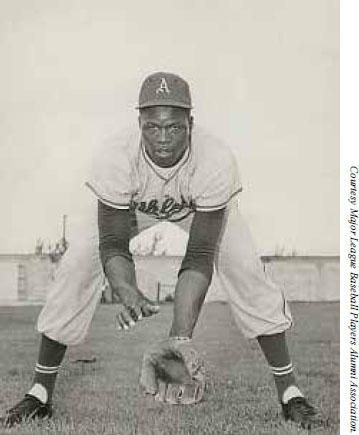Al Pinkston: Forgotten Color Line Casualty
This article was written by Will Christensen
This article was published in When Minor League Baseball Almost Went Bust: 1946-1963
Al Pinkston. (Courtesy Major League Baseball Players Alumni Association)
Al Pinkston was one of hundreds of minor-league stars whose career accomplishments came to light decades later thanks to the efforts of SABR.
For the most part, Pinkston’s numbers, outstanding though they might appear, seem a bit pedestrian compared with others in SABR’s first volume of Minor League Stars. He doesn’t have the highest batting average, the most homers, or the most hits of any minor leaguer.1
There’s a reason for that, and it makes Pinkston’s career all the more fascinating.
Pinkston, like many other players, broke into Organized Baseball in the low-level minors, with Farnham in the Class-C Provincial League in 1951. When he hung ‘em up 15 years later, he had six batting titles to his name on his way to a .352 batting average over the course of 1,827 games.2 His .372 mark after seven seasons in the Mexican League is the all-time high in that league for any player who has more than 2,400 at-bats.3
Pinkston wasn’t just a singles hitter. He led his league in home runs once, RBIs four times, and total bases five times. His career on-base percentage is .412; his career slugging average is .554.
That’s pretty good. Now, here’s where it gets really interesting. Pinkston’s first season, in 1951, when he hit .301 with 15 homers and 21 steals, the kid was all of 33 years old, having been born in October 1917.
Thirty-three.
At age 33, Sandy Koufax had been retired for a year. Pinkston, who was known as Beartracks, among other nicknames, presumably for his huge feet and stride (he was listed at b-fcct-SL with a size 14 shoe4), was just getting started.
The next year, Pinkston won the Provincial League triple crown while playing with St. Hyacinthe, thus beginning a career that finished with more than 2,300 hits, 1,300 RBIs, exactly 250 homers and the aforementioned .352 batting average.
As one might suspect, Pinkston ranks among the top five professionally in just about every category for players after age 33 and is at the top of the list in doubles (461), extra-base hits (786), total bases (3,729), and, most importantly, runs created (1,468).
Naturally, considering how good Pinkston was after an age when most players are either retired or winding down their career, the obvious question is: What the heck was he doing before 1951?
Well, he was doing a lot of things men his age were doing: working,5 getting married,6 starting a family,7 fighting a world war8 … and playing a little baseball. Of course, Pinkston’s options to play professionally were limited severely, because he had committed Organized Baseball’s cardinal sin of being born Black.
There’s a perception that when Jackie Robinson broke the color barrier in 1946 before moving up to the White major leagues in 1947, Black players suddenly had equal opportunities to play in the minors and majors.
Not true, of course. The American and National Leagues weren’t fully integrated, that is, with every team having at least one Black player, until 1959. The minor leagues weren’t fully integrated, as in every league had at least one Black player (let alone team), until 1963.9 Between 1946 and 1963, progress happened incrementally.
So Pinkston actually didn’t have much opportunity to get into Organized Baseball any sooner than he did.
Pinkston played in the Negro Major Leagues, sort of. He got all of one at-bat with the Cleveland Buckeyes in 1948. He also played for the St. Louis Stars in 1936 when it was an independent team. All of 18 at the time, Pinkston played well enough to be mentioned as a candidate for the 1936 East-West Game (he didn’t play in the game),10 but no stats for the season exist.
In between those two stints, only an anecdotal record remains. From 1947 to 1950 Pinkston played with the New Orleans Creoles in the Negro Southern Association and Negro Texas League,11 and only a few box scores from that period are generally available. By 1949 and 1950, certainly, Pinkston was drawing interest from Organized Baseball.12
Despite the late start, Pinkston still almost made the extant majors. Having been acquired by the Philadelphia A’s organization before the 1952 season,13 he raced up the ladder, and after a monster season in the Class-A Sally League, he got a spring-training invite with the big club, then from Kansas City, before the 1955 season.14
At the time Pinkston was trying to pass himself off as nine years younger,15 which was why he got a shot at all. It later was suggested that in talking about his past, Pinkston let slip a few facts that messed with his known timeline,16 but it’s more likely that a .226 mark with no homers or RBIs during the exhibition season put him in Triple-A ball.17
An injury-riddled 1955 season18 and a decline in 1956 then doomed him to the minor leagues, where he became a Hall of Famer (in Mexico)19 and a legend. He played with Los Diablos Rojos del Mexico in 1959 and 1960 and with Los Rojos del Aguila de Veracruz from 1961 through 1965.20
For the record, this was Pinkston’s “average” season for the next nine years after 1956, when he was 38 and playing on bad knees:21
What could have been for Pinkston had baseball been a true meritocracy all along and he got to play in his 20s: 4,000 career professional hits? 500 homers? 2,000 RBIs? Arun as a major-league All-Star? We can only wonder.
Will Christensen is a former journalist, avid researcher, and certified minor-league baseball nut. He has been a member of SABR since 1986 and has been interested in minor-league baseball most of the time since then. His first game to watch was the Columbus Jets during the team’s final season in 1970.
Acknowledgments
This article was edited by Thomas Rathkamp and fact-checked by Tony Escobedo.
Notes
1 The first volume of Minor League Stars was published by SABR in 1978. Two subsequent volumes followed.
2 Roberto Hernandez, “Pinkston Second to Cop Six Swat Titles in Minors,” The Sporting News, November 10, 1962: 23. Pinkston hit .360 in the Provincial League in 1952; .360 in the South Atlantic League in 1954; and .369, .397, .374, and .381 in the Mexican League in 1959 to 1962.
3 Pedro Treto Cisneros, The Mexican League (Jefferson, North Carolina: McFarland & Company, Inc., 2000), 53.
4 Brad Willson, “Cullop Plans Heavy Workouts for Jets,” Columbus (Ohio) Dispatch, February 28, 1955: 14.
5 US Census Bureau, Sixteenth Census of the United States, 1940. Pinkston was listed as still living at home in Newbern, Alabama, as a farm laborer.
6 Dr. Layton Revel and Luis Munoz, “Forgotten Heroes: Alfred Pinkston,” Center for Negro League Baseball Research, 2013: 2. This otherwise excellent downloadable biography incorrectly listed Pinkston’s new bride as Vera Lewis. It was Velma Lewis, but no date was mentioned or found.
7 “Vital Statistics,” New Orleans Item, November 4, 1943: 2. This listing mentions the birth of a girl to a “Mesdames Alfred Pinkston.” Another listing dated November 6, 1946, reports the birth of a boy to a “Mesdames Alfred C Pinkston.” Pinkston’s middle name was Charles, and Pinkston’s first two children were a daughter and son in that order, so it’s safe to assume these are his first two children.
8 US Department of Veteran Affairs, BIRLS Death File, 1850-2010. The file lists a prewar enlistment of August 7, 1941, and a discharge of January 24, 1946. Revel and Munoz report Pinkston was discharged in 1944 but cite no source to confirm. In any event, it appears Pinkston spent the entirety of his service in New Orleans.
9 Oscar Kahan, “22 Clubs, Only 20 Tieups, Add Up to Headache,” The Sporting News, December 8, 1962: 8.
10 “Announce All Star Game,” Chicago Defender, August 8, 1936: 14.
11 Revel and Munoz, “Forgotten Heroes: Alfred Pinkston”: 4.
12 James LaFourche, “Scouts Trailing Three Negro Players,” Northwest Enterprise (Seattle), September 7, 1950: 1.
13 “Importante transaction bâclée entre les clubs Famham et S. Hyacinthe,” Le Clarion (St. Hyacinthe, Québec), January 25, 1952: 7.
14 Walter L. Johns, “A’s Put Finger on Pinky, 227-Pound Sally Slugger,” The Sporting News, March 16, 1955: 15.
15 Sam Lacy, “Long Jump to Majors Fails to Dim Al Pinkston’s Hopes,” Baltimore Afro-American, April 9, 1955: 17.
16 John Schulian, Twilight of the Long-Ball Gods (Lincoln: University of Nebraska Press, 2005), 66-67.
17 “Averages,” Kansas City Times, April 1, 1955: 40.
18 “Meet the Jets,” Columbus Dispatch, April 13, 1956: B-23.
19 “Mexican League,” The Sporting News, July 20, 1974: 36.
20 https://www.baseball-reference.com/register/player.fcgi?id=pinkstooialf.
21 Hernandez. An apparently unpublished feature by Bill Bryson from 1957 found in The Sporting News archives quoted Pinkston as saying, “I don’t know how my knees are going to hold up. I got bad cartileges [sic] in both of ‘em.”


